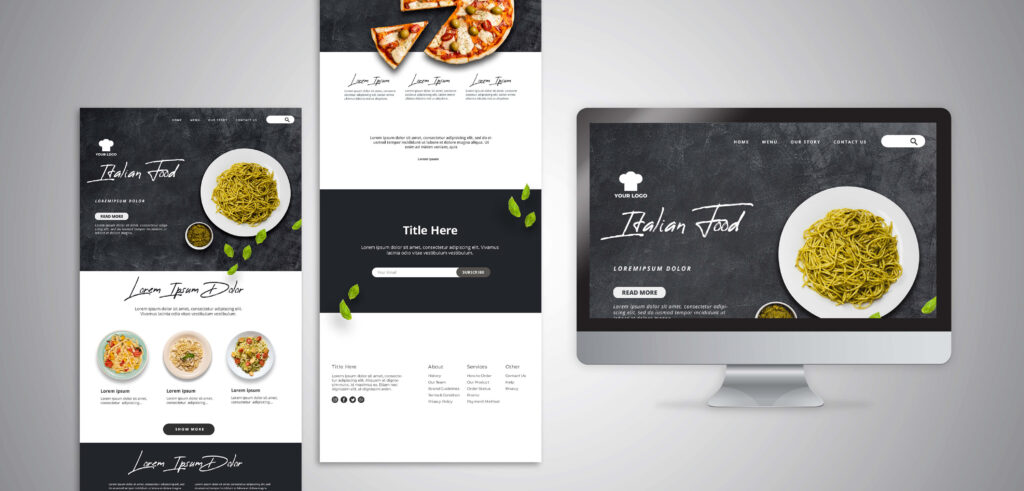In the realm of visual communication, graphic design serves as the cornerstone for captivating and effective messaging. Whether it’s crafting a logo, designing a website, or creating marketing materials, adhering to certain principles can significantly enhance the impact of your designs.
The details are not the details. They make the design.
– Charles Eames
Here are 10 thumb rules that every graphic designer should keep in mind to create compelling and visually appealing artwork.
👉🏼 Design with Purpose

Before diving into the design process, it’s crucial to have a clear understanding of the project’s objectives. Whether it’s conveying a brand message, promoting a product, or simply providing information, aligning your design with the intended purpose ensures coherence and effectiveness.
Understanding the Objectives of Graphic Design for Various Platforms
- Brochure Design: Brochures serve as powerful marketing tools, providing detailed information about products, services, or events. The primary objective of brochure design is to inform and persuade the audience, encouraging them to take action. Key considerations include clarity of information, visual appeal, and alignment with brand identity.
- Hoarding Design: Hoarding design aims to grab attention and communicate a message quickly to a broad audience. The objective is to create visually compelling and memorable designs that leave a lasting impression on passersby. Bold typography, vibrant colors, and impactful imagery are essential elements of effective hoarding design.
- Social Media Creatives: In the realm of social media, graphic design plays a crucial role in capturing the audience’s attention amidst a sea of content. The objectives of social media creatives vary depending on the platform and campaign goals. Whether it’s promoting products, driving engagement, or increasing brand awareness, the key is to create visually engaging content that resonates with the target audience.
- Website Design: Websites serve as digital storefronts for businesses, making website design a critical component of online branding and user experience. The primary objective of website design is to create an intuitive and visually appealing interface that guides users through the content seamlessly. Factors such as navigation, usability, and responsive design are essential considerations.
- Packaging Design: Packaging design goes beyond aesthetics; its primary objective is to protect the product and communicate its value to consumers. Effective packaging design should attract attention on the shelf, convey brand identity, and provide relevant product information. Considerations such as materials, functionality, and shelf impact play a crucial role in packaging design.

👉🏼 Prioritize Simplicity
Simplicity is key to successful graphic design. Strive for clarity and avoid clutter by keeping your designs clean and uncluttered. Simplified visuals not only make it easier for the audience to grasp the message but also create a lasting impression.
- Clarity of Message: Simplicity ensures that the message is clear and easily understood by the viewer. Complex designs can confuse the audience and dilute the intended message.
- User Experience: Designs that are easy to comprehend enhance the user experience. Viewers appreciate designs that are intuitive and straightforward, leading to increased engagement and interaction.
- Visual Hierarchy: Simplified designs allow for better control of visual hierarchy, guiding the viewer’s attention to the most important elements. This helps in conveying the intended message effectively.
- Memorability: Simple designs are often more memorable. Viewers are more likely to remember a clean and uncomplicated design compared to a cluttered or overly complex one.
- Versatility: Simple designs tend to be more versatile and adaptable across different mediums and platforms. They can easily be scaled, resized, and repurposed without losing their effectiveness.
- Brand Identity: A simplified and consistent design approach helps in building a strong brand identity. Viewers can easily recognize and associate the design with the brand, leading to increased brand recall and loyalty.

👉🏼 Maintain Consistency
Consistency is vital for establishing brand identity and fostering recognition. Use consistent colors, fonts, and design elements across all marketing materials to create a cohesive brand experience and reinforce brand recall.
- Use Consistent Brand Elements: Ensure that your brand’s colors, fonts, logos, and other visual elements are consistent across all marketing materials, including websites, social media posts, print ads, and packaging.
- Create Brand Guidelines: Develop comprehensive brand guidelines that outline the proper usage of your brand elements. This document should include specifications for colors, typography, logo usage, spacing, and other design elements.
- Stick to a Design System: Implement a design system that defines rules and standards for creating and organizing design elements. This system helps maintain consistency and streamlines the design process across various platforms and projects.
- Apply Consistent Layouts: Establish consistent layouts for different types of content, such as social media posts, blog graphics, and promotional materials. This ensures a unified look and feel across all branded content.
- Maintain Visual Harmony: Ensure that your designs have visual harmony by balancing elements such as text, images, colors, and white space. Consistency in visual hierarchy helps guide the viewer’s attention and creates a pleasing aesthetic.
- Test Across Platforms: Test your designs across different platforms and devices to ensure that they appear consistent and visually appealing. This includes desktop computers, mobile devices, tablets, and various web browsers.
- Regularly Review and Update: Periodically review your brand guidelines and design assets to ensure they remain relevant and effective. Update them as needed to accommodate changes in branding strategy or design trends
👉🏼 Focus on Typography
Typography plays a pivotal role in graphic design, influencing readability, hierarchy, and overall aesthetics. Choose fonts wisely, ensuring they complement the brand personality and are legible across different platforms and screen sizes.
- Choose Fonts Wisely: Select fonts that not only align with the brand’s personality and values but also reflect the intended message and target audience. Consider factors such as serif or sans-serif, readability, and appropriateness for the intended context.
- Maintain Readability: Prioritize readability by choosing fonts that are easy to read, especially in various sizes and formats. Avoid overly decorative or intricate fonts that may hinder legibility, particularly in smaller sizes or on low-resolution screens.
- Establish Hierarchy: Use typography to establish a clear hierarchy of information within your designs. Differentiate between headings, subheadings, body text, and other elements using variations in font size, weight, style, and color.
- Create Contrast: Utilize contrast in typography to draw attention to key elements and create visual interest. Contrast can be achieved through variations in font size, weight, style, color, and spacing.
- Ensure Consistency: Maintain consistency in typography across all brand materials to reinforce brand identity and foster recognition. Establish guidelines for font usage and stick to them across various platforms and marketing channels.
- Mind Spacing and Alignment: Pay attention to spacing and alignment to ensure optimal readability and visual appeal. Proper line spacing, letter spacing (tracking), and alignment contribute to a clean and polished typographic layout.
- Consider Accessibility: Keep accessibility in mind when choosing fonts and designing typography. Select fonts that are accessible to all users, including those with visual impairments, by ensuring sufficient contrast and legibility.
- Test Across Platforms: Test your typography across different platforms, devices, and screen sizes to ensure optimal legibility and visual consistency. Adjust font sizes and styles as needed to accommodate various viewing conditions.
- Experiment and Iterate: Don’t be afraid to experiment with typography to find the best fit for your design objectives. Iterate on different font combinations, styles, and layouts until you achieve the desired look and feel.

👉🏼 Embrace White Space
White space, also known as negative space, is the breathing room within a design that enhances visual appeal and readability. Don’t overcrowd your designs; instead, leverage white space strategically to create balance and draw attention to key elements.
- Prioritize Balance: White space helps achieve visual balance by providing a sense of equilibrium between elements in a design. Distribute white space evenly throughout the layout to create a harmonious composition where no single element dominates.
- Enhance Readability: Adequate white space around text and other elements improves readability by reducing visual clutter and allowing content to breathe. Ensure sufficient spacing between lines of text, paragraphs, and surrounding graphics to facilitate easy scanning and comprehension.
- Highlight Key Elements: Use white space strategically to draw attention to key elements or focal points within your design. By surrounding important content with ample white space, you can make it stand out and command the viewer’s attention more effectively.
- Create Visual Flow: White space can guide the viewer’s eye through a design, leading them from one element to the next in a natural and intuitive manner. Arrange elements with careful consideration of white space to establish a smooth visual flow and encourage exploration.
- Convey Elegance and Sophistication: Thoughtful use of white space can convey a sense of elegance, sophistication, and professionalism in your designs. Minimalist layouts with generous white space often exude a sense of refinement and modernity, leaving a lasting impression on viewers.
👉🏼 Use Color Thoughtfully
Color has the power to evoke emotions, convey messages, and influence perceptions. Understand the psychology of colors and use them thoughtfully to reinforce brand identity, create contrast, and evoke the desired response from your audience.

👉🏼 Prioritize Visual Hierarchy
Establishing a clear visual hierarchy guides the viewer’s eye through the design and highlights essential elements. Use size, color, contrast, and placement to create hierarchy and ensure that important information stands out.
- Use Contrast Effectively: Utilize contrast in size, color, and font weight to distinguish between different elements within your design. Ensure that important information, such as headings or calls to action, stands out prominently against background elements. By incorporating strong contrasts, you can direct the viewer’s attention to the most critical parts of your design.
- Employ Consistent Formatting: Maintain consistency in formatting throughout your design to establish a clear visual hierarchy. For example, use consistent font styles and sizes for headings, subheadings, body text, and captions. Consistent formatting helps viewers quickly identify the importance of each element and navigate the content more efficiently.
- Apply Gestalt Principles: Consider applying Gestalt principles, such as proximity, similarity, and closure, to organize and structure your design elements effectively. Group related elements together to indicate their relationship and importance within the overall composition. By leveraging Gestalt principles, you can create intuitive visual cues that guide the viewer’s perception and enhance the clarity of your design’s hierarchy.
👉🏼 Optimize for Readability
Whether it’s a poster, website, or social media graphic, readability is paramount. Ensure that text is legible by choosing appropriate font sizes, contrast levels, and line spacing. Test your designs across various devices and screen sizes to guarantee readability.
👉🏼 Incorporate Visual Balance
Achieving visual balance involves distributing elements within a design in a way that feels harmonious and aesthetically pleasing. Experiment with symmetry, asymmetry, and the rule of thirds to create balance and visual interest.

👉🏼 Seek Feedback and Iterate
Finally, don’t hesitate to seek feedback from peers, clients, or target audience members. Embrace constructive criticism as an opportunity for growth and refinement. Iterate on your designs based on feedback to continually improve and evolve as a designer.
- Choose the Right Audience: Selecting the right audience for feedback is essential. Ideally, seek input from individuals who represent your target demographic or stakeholders who have a vested interest in the project’s success. Their perspectives will be most valuable in evaluating the effectiveness of your designs.
- Encourage Honest Feedback: Create a safe and open environment where feedback can be shared candidly and constructively. Encourage reviewers to provide honest opinions, even if they differ from your own. Constructive criticism, though sometimes challenging to hear, is invaluable for identifying areas of improvement.
- Listen Actively and Analyze Critiques: When receiving feedback, listen attentively and avoid becoming defensive. Take notes on the specific points raised and analyze critiques objectively. Look for recurring themes or patterns in the feedback, as these often indicate areas that require attention or refinement.
- Iterate Thoughtfully: Use feedback as a springboard for iteration and refinement. Implement changes based on the feedback received, keeping your original objectives in mind. Be thoughtful and intentional in your revisions, focusing on addressing the identified weaknesses or shortcomings while preserving the strengths of your design.
By adhering to these 10 thumb rules of graphic design, you can elevate your designs from ordinary to extraordinary. Whether you’re a seasoned designer or just starting, incorporating these principles into your workflow will help you create impactful and visually stunning artwork that resonates with your audience.
There are three responses to a piece of design – yes, no, and WOW! Wow is the one to aim for.
– Milton Glaser


